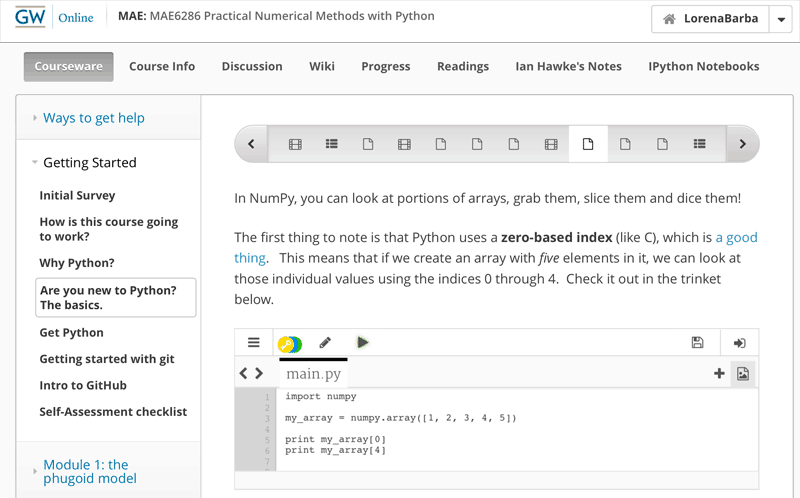What’s Open edX?
A brief introduction to Open edX, the open source platform that powers edX courses.
Editors Note: This is a guest post by Lorena A. Barba, an associate professor of mechanical and aerospace engineering at George Washington University. It was originally published here.
Most people are familiar with edX.org, the provider of MOOCs (massive open online courses) from a selection of the top universities around the world. EdX developed a software platform to offer its courses that became Open edX when it was released as open-source software on June 2013.
The release of Open edX was part of the agreement made with Stanford, who contributed functionality (like bulk email) from its own open-source learning platform, Class2Go. The April 2013 MIT Press Release promised a close collaboration between the two giants to “support and nurture” a community of developers.
This collaboration sometimes appeared strained, however; especially with Stanford’s report on Open edX, published in May 2014 (the full report is a public Google document). It warns that “adoption is at risk of faltering,” and goes on to list needed technical improvements, governance, and community building. EdX responded with a roadmap for the platform development and commitments to increase adoption.
Despite the hiccups, the Open edX software powers major MOOC initiatives around the world. The first national adoption was by the French Ministry of Higher Education in October 2013, resulting in the portal France Université Numérique (FUN). Then came the Chinese portal XuetangX, EdRaak in the Arab world, Gacco in Japan, and various other international adoptions.
In the US, only Stanford hosted its own Open edX platform until about a year ago. The George Washington University was the second US university to deploy Open edX for a successful MOOC starting August 2014. IBL Studios were our technical partners and Class Central (our media partners) were the first to report it; eCampus News followed with more detailed coverage.
The list of sites powered by Open edX is now quite long and, notably, includes several companies that are using mini-MOOCs as part of their content strategy, and others that are using the platform for skills training.
Features of Open edX
Open edX is not one software, but two: one for creating courses, called Studio, and one for taking online courses (a.k.a., LMS for learning management system).
Open edX presents courses organized in a hierarchy of sections, sub-sections and units. Often, MOOCs associate course sections to “weeks” of study, each including a handful of lessons as sub-sections. These two components (sections and sub-sections) appear on a vertical navigation bar on the left. Units appear sequentially on a horizontal navigation ribbon. This simple three-level hierarchy makes for a pleasant, guided learning experience.
Other learning platforms, for example, present learning content classified by type: videos, handouts, assignments, etc. The learner is thus forced to click back and forth between different top-level categories to follow a learning sequence. (This is how older Coursera courses were organized, and many still are.)
Open edX screenshot, showing the vertical section/sub-section navigation (left) and the learning-sequence ribbon. Also seen is an embedded app (Trinket) in an iframe.
Screenshot showing the video player in Open edX, with captions. Clicking on a text fragment sends the player to that spot on the video.
Units in Open edX can have several components (the most granular course content type): video, HTML text, problems, and discussions. The video player is particularly good: learners can adjust the playback speed, or click on a sentence of the transcript to be sent to that spot on the video. For course builders, too, the experience is seamless: enter the YouTube URL in a little box and upload the transcript (an .srt file) and presto!
The problem components are another strength of the platform. Instructors can choose between drop-down, multiple choice, checkboxes, numerical input, text input, problems with hints and feedback, and many types of advanced problems (Python-evaluated input, Javascript display and grading, math expression input, and many more).
A course can also have a wiki, a textbook uploaded as PDF files per chapter (a bit cumbersome for the course builder), and static HTML pages for custom content like lists of readings with links to outside content.
Learners can see a progress bar showing them their scores for all graded sub-sections. Instructors, for their part, can pull out the progress of any particular learner, or download a full CSV file of the grade book.
Any learning platform can be used for well-designed courses or bad courses, but Open edX makes it easy to create the first kind.
It’s unique
The press release about the Stanford-edX collaboration and the release of Open edX said:
“Open source online learning platforms will allow universities to develop their own delivery methods, partner with other universities and institutions as they choose, collect data, and control branding of their educational material.”
What makes Open edX unique is that it is the only last-generation, full-featured, open-source platform for online learning. The closest alternative is Canvas—but Canvas is a hybrid open/closed product, as legendary Dr. Chuck so eloquently explained in a short passage of a long post.
Open edX has the potential to enable independent online-learning initiatives, where instructors maintain control of their intellectual property and institutions protect learner data.
This potential has not yet been realized, in part due to the many technical difficulties of installing and managing the platform. (A quick browse of the Open edX forum shows that many are stuck, with little help from edX.)
Collaboration across institutions that want to control their online content and platforms is one way to move over the obstacles of adopting new technologies to enrich learning.








